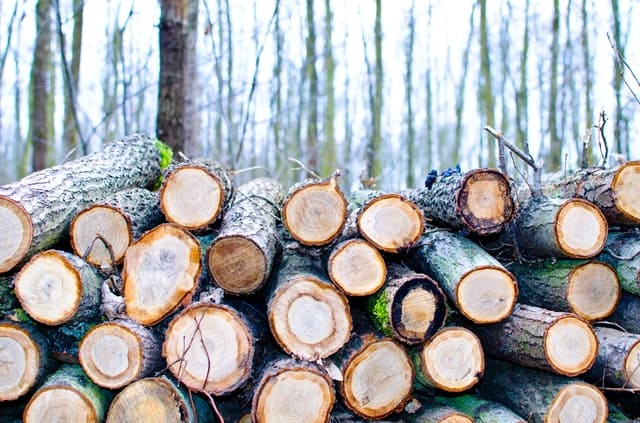What is Timber and What Are Various Uses of Timber?

Timber is the most important element used for making furniture. It is also extensively used in the production of beams and planks. Lumber or timber, a wood which is capable of yielding the minimum size of a dimension, is generally produced from growing woods. It’s mainly used for building a structure or for other reasons.
Timber is quite in demand as it finds its use for making building material, furniture, and various other purposes. Let’s take a look at various properties and uses of timber.
Properties of Timber
Before you use timber, you should know its properties. You must also scrutinize the physical and mechanical properties of timber before using it.
Color: The lighter the color is, the weaker is the timber. There is a variation of color from one tree to the other. If you observe carefully, freshly cut walnut, teak, and deodar have dark brown, golden yellow and whitish color shades respectively.
Appearance: Good timber is known by its characteristic aroma.
Hardness: Check the hardness of timber for resistance and other attributes.
Specific Gravity: Usually, the specific gravity (the ratio of its density to that of the other) of timber varies from 0.3 to 0.9. The specific gravity depends heavily on the pores present. As the pores decrease, it may increase to more than 1.5.
Moisture Content: Timber is naturally hygroscopic. The more the water content, the more it is susceptible to fungal attacks.
Grain: Grain arrangement in timber can be of various types like straight, coarse or interlocked.
Shrinkage or Swelling: Shrinkage in timber generally occurs after cutting and drying. When the cell wall of timber starts losing water, shrinkage gets underway. However, if the timber quality is good, then they usually do not swell.
Strength: A quality timber is known to have the highest strength. The more the strength, the more is the ability to bear loads. The best strength for timber is 500 kg/square cm to 700 kg/square cm. When the bending strength is more, it generally indicates good quality.
Density: Good quality timber has a thicker wall and higher density. The more the moisture content, the lesser is the density of timber.
Toughness: Timber has a high capacity of bearing shocks and jerks. Older timber with annular rings is a good indication of quality.
Elasticity: Timbers generally attain its own shape after usage.
Durability: Good timber is known by its resistance power to fungal attack.
Soundness: A timber of good quality always produces a good sound.
Quality: Superior quality timber is generally free of abrasion.
Various Uses of Timber
Fuel
The primary usage of timber is for fuel. Around 40 percent of timber used in forests around the world is utilized as fuel. However, the proportion of timber used as a fuel around the world differs with the usage of other alternatives available such as coal. The African and South American countries consume a more substantial portion of timber as fuel, the use of which is made for both commercial and domestic purposes.
While in Malaysia, a considerably smaller portion of timber is used as fuel. They use kerosene, gas, and electricity as primary domestic fuel. Now in Japan, since there is a shortage of domestic coal and oil supplies, it leads to greater use in timber. About one-sixth of the fuel supply comes from timber production there. In India, however, the scenario is quite different as the timber production is at least 5 times lesser than what is actually required.
In Finland timber is cheap and is readily available as fuel compared to coal. Countries in Southern Europe like Spain, Turkey, and Yugoslavia, where the standard of living is lower than in other parts of Europe, the use of timber is proportionally higher. Latin American countries use coal for commercial purposes compared to timber. North America uses a lesser portion of timber as fuel while Canada uses only 5 % timber for fuel purpose.
Construction
Apart from fuel, the most vital usage of timber is in the building industry. Despite having enough use of steel and concrete in the construction industry, there is considerable use of timber for building bridges and parts of houses.
With the growing population, the number of construction work in the world is increasing daily; hence the utilization of timber has also seen exponential growth. Timber is widely used in work wood producing boxes, furniture, matches, and crates.
Most of the timber used from the tropical forests is hardwood. Normally, timber finds use in the construction industry in three ways mainly as – sawn wood, veneers and plywood, and fibreboards.
Sawn Wood
Here, timber is mainly used for heavy duty construction like railway sleepers, construction piers, jetties and other hardwoods like resistant jarrahs, and karri woods of Australia.
Plywood and Veneers
Timber when used in the form of planks, woods that is usually cut into thin sheets and glued together to form a strong and durable material, is called plywood. These are commonly used more for internal construction like doors and furniture. Sheets of valuable wood like mahogany, ebony, oak, and walnut are also useful for furniture making.
Fibreboards
The use of timber in fiber and particle boards is also common. They are made from sawdust, pulp, and other waste materials. Boards like chipboard, block-board, and hardboard usually utilized in making furniture and all internal constructions like ceiling, lining, etc.
Pulp & Paper
Timber has an ever-increasing demand in the paper and pulp industry. Generally, timber contains two substances – cellulose and lignin which is used as the object of pulping and extracting cellulose from paper. Note that timber is not the only substance which produces paper, but a variety of vegetable fiber can also make paper.
Temperate hardwoods can be used for pulp production. Different processes by which wood gets converted to paper can be mechanical, chemical, and semi-chemical. The USA derives almost 10% of its production from the semi-chemical process. The pulp so produced is usually put to use in making heavy-duty cardboard.
Paper is not the only product of the pulp industry. The use of other products such as fibreboards and particle boards are also common for constructional purposes. Sawmill residues are highly utilized in the USSR, USA, and Sweden. Much of the forest waste also finds its use in the production of resinous material forming a board.
Synthetic Textiles
Wood cellulose that forms the basis of synthetic textiles is known as rayon. The cellulose, when dissolved in caustic soda and carbon bisulphide, and extruded through a spinneret, produces filaments of viscose rayon.
The rayon filaments can be used to produce ‘artificial silk’ that may be cut into staple lengths. They will also be spun, dyed, woven and finished like the artificial silk. The leading rayon producers are Japan, USA, and other European countries like Italy.
Other Uses
Timber has a wide array of uses in different industries like chemicals and dyestuffs. These applications have been superseded by the development of resin and synthetic chemical dyes. It also finds its usage for yielding other materials like gum, tannin, drugs, and resin. Besides, timber is also utilized in producing a host of other equipment such as artificial limbs, air dispensers, terraces, decks, balconies, beehives, cladding, sculptures, carvings, saunas, scaffoldings, bathtubs, shingles and smoking produces.
Timber is also used in making various sports goods and musical instruments, as building blocks for ships, buses, and trains, for decorative purposes in homes and offices in the form of showcases and furniture. Timber is also used in light construction works like doors, windows, flooring, roofing and fencing poles, electric poles and gates.
There are several benefits of using timber like they are 100% renewable resource, ecologically safe and has various natural aesthetic interests. Moreover, timber also helps in reducing greenhouse gas emission. In places like Australia, timber is even utilized in various renewable energy sources thereby contribute to improving the local economy.






